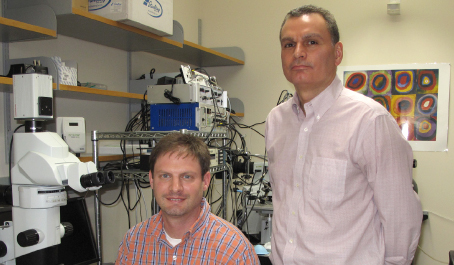
The delivery man
Can neuroscience breach the brain’s defenses to combat anguishing diseases like dementia? The answer may take a backdoor.
But for Robert Thorne the devil’s in the details and the journey is personal.
If science didn’t caution against dreams, here’s a wild one: a father is succumbing to brain cancer. Yet there may be hope to save his life. His doctor recommends a drug – a large molecule like an antibody. He’s prescribed a nasal spray and told to administer once a day.
Over time the medicine does more than patch up his ravishing symptoms. It defeats his disease.
His family calls it a cure, or perhaps a dream.
In a laboratory in Rennebohm Hall, Robert Thorne picks up the 700-page textbook he co-authored. The UW-Madison neuroscientist has sick brains on his mind.
“There are lots of potential drugs we can use to treat brain disorders like cancer, Alzheimer’s, Parkinson’s, you name it. Most major universities have big science programs that will go on identifying fantastic drug candidates.”
The textbook hits the desk like a brick, rattling the papers and model globe.
“But at some point we have to get the drugs practically into the nervous system. The challenge, really for decades, has been the challenge of delivery.”
He argues the fundamental problem is missing information. In the year 2014 the brain and its labyrinth of pathways continue to puzzle neuroscience.
“There have been a lot of people researching how to get big molecules and proteins into the brain but everything’s been a dismal failure. Why? Because we haven’t understood well enough how things work.”
He feels this frustration as a researcher and as a son.
“My father died of brain cancer about 25 years ago. I know through that experience with him where the limitations are.”
For more than two decades Thorne has been traveling the brain to understand its pathways, neurons, mechanisms and mysteries. His goal is to leverage this deep knowledge of anatomy and systems to discover the best inroads for medicine.
He explains that if the brain is a holy grail, it is guarded by a physiological fortress called the blood brain barrier.
“The blood brain barrier is the gold standard of barriers,” says Thorne. “It’s tight. It has all sorts of mechanisms to keep substances out.”
The barrier shields the mammalian brain from the infinite hazards circulating through the body, permitting only a few molecules such as glucose to penetrate. But it’s too much of a good thing. It also obstructs large, potentially lifesaving drugs like proteins and antibodies.
Picture a truck trying to get through a doorway, he says.
For this reason companies have focused on small, fat-soluble drugs taken orally that cross the intestine and slip into the brain through the bloodstream.
“The pharmaceutical industry has been bent on this model of drugs. So right there you should see the problem,” says Thorne. “Any drug that isn’t very small and fat soluble has not been utilized.”
Bigger drug candidates – proteins, peptides, antibodies – have been left out in the cold.
Thorne and his team are pursuing an alternative strategy. Rather than trying to slip through the blood brain barrier, bypass it altogether.
There are several methods that attempt this, including neurosurgery.
“You may be surprised to find out that one of the state-of-the-art strategies we have for delivering drugs to the brain is sticking a catheter directly into the brain tissue,” says Thorne.
Yet another method may be the most intriguing. Use the nose as a backdoor to the brain.
The neurons in our nasal passageways are surprisingly exposed to the outside world, Thorne explains. When you sniff a glass of wine, for example, scent-carrying particles called odorants drift into the nose and physically bind to receptors.
These easy-access neurons could serve as bridges to the brain for medicine. There’s a catch. The nasal epithelium is a barrier, and the larger drugs still have trouble penetrating.
Thorne and his team offer a solution. They realized that exposed neurons are vulnerable neurons, perpetually dying and sprouting like seedlings. How? A protein factor naturally found in the nose, called matrix metalloproteinase-9 (MMP-9), loosens the nasal epithelium like a fresh rain.
Spray the nasal passageway with an extra dose of MMP-9 and what happens? Will it help the big drugs pass through? Will the epithelium seal back up? Is it toxic?
Support from the Accelerator Program is helping Thorne take the next step and answer these critical questions using rodent models. His team, including research associate and co-inventor Jeff Lochhead, is tracking radioactive and fluorescently tagged antibodies through the animals’ tissue to learn where they go, how they get there, and whether or not they actually end up in the right places in the brain.
“The Accelerator Program has helped me think about what could be done to enhance the prospects of finding an industry partner,” says Thorne. “Having the chance to present the work to the biopharma Catalysts was a great experience.”
For Thorne, his research has vintage appeal. The mere possibility of intranasal drug delivery was the topic of his thesis as a graduate student 20 years ago in Minnesota.
“The low-hanging fruit in science is always picked,” he laughs. “The more headway we can make, the closer we get to what everybody in my field wants to do: finally have success.”